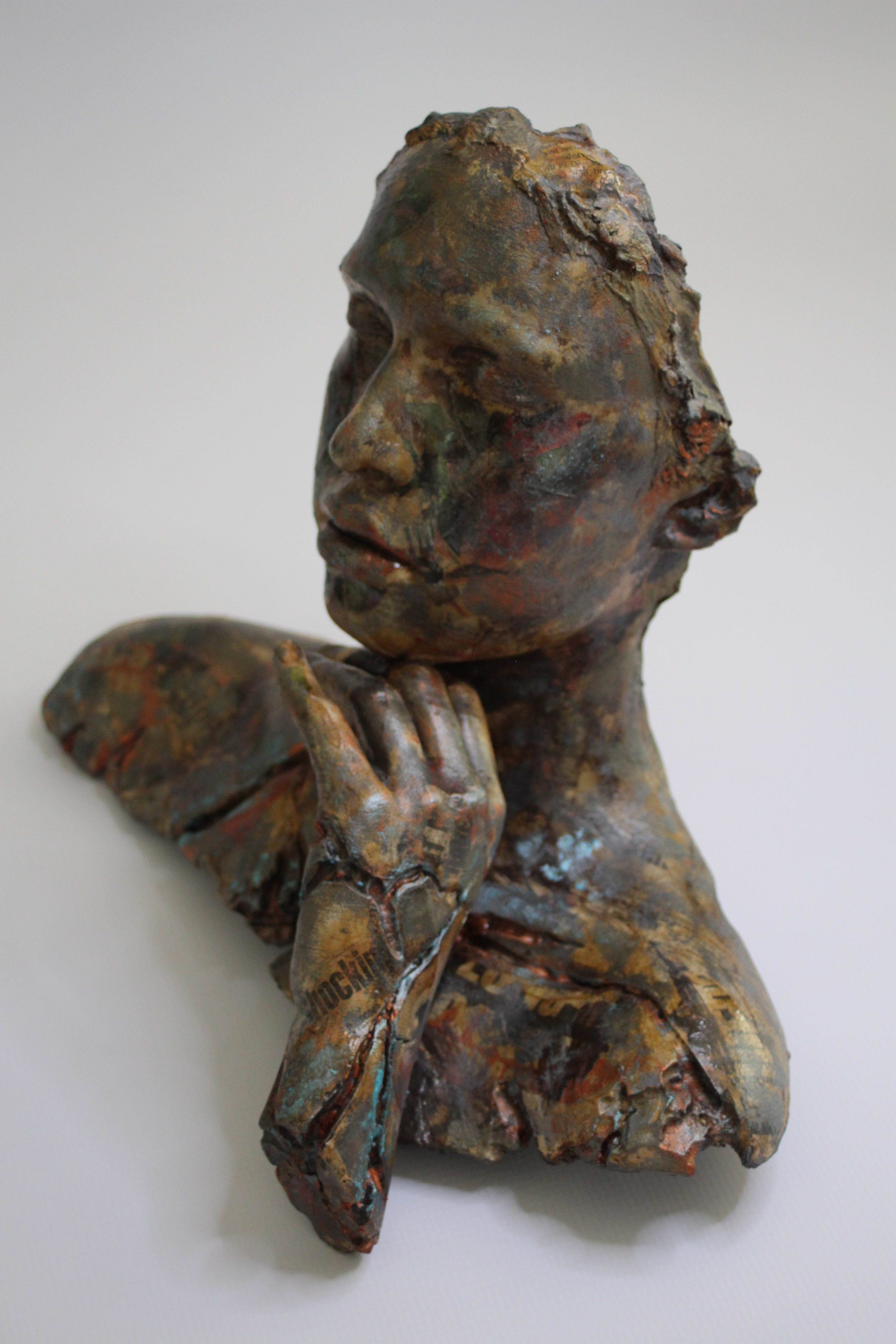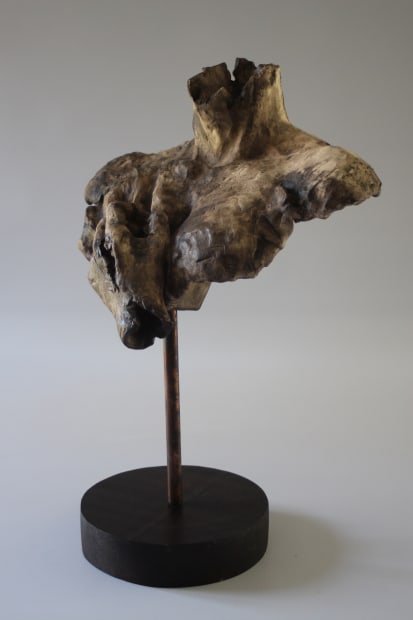-
-
Q: You use clay to create your sculptures. Why did the idea of creating something from the Earth intrigue you so?A: Clay is a soulful medium to work with. The concept or the theme that is accepted by many cultures and religions is that the human being is created from a lump of clay. The material resonates with me because I am creating female forms, portraiture and other objects from this very material that is the essence of what a human is. Clay also comes in a myriad of colours, textures and compositions, just like humanity, different but we are all the same in essence.It is a beautiful medium to work with technically as it is very malleable. In some instances it lends to what I am trying to say. When considering my sculptures of busts and torsos, what I like about clay is that it can be moulded and formed just the way society tries to mould and form women. What I then do with those torsos and busts is that I let them crack and fracture, which then signifies the sort of pressure of societal expectations that are often placed onto women.I am currently working on a body of work where I am using construction tools, often associated with manly work, and then making them from porcelain material often associated with femininity. In doing this I am subverting the roles that society places on men and women. By making something that is associated with the domain of men with a material associated with women, I am questioning gender norms and the materiality of it by asking whether a tool made from porcelain can actually be effective and in doing so, looking at whether these roles we impose on modern society are effective.
-
.Q: Your sculptures are intended to depict women in a manner that is multi-dimensional, not one dimensional and without agency. Can you please elaborate on that?A: I love working three-dimensionally and it could be a factor owed to me working as a dental technician for the last 30 years where one works in three-dimension. What I like about the three-dimensionality is that it again lends to what I am saying about women. I do not want women to be constructed as one-dimensional objectified beings. My art is about engaging with a woman from all angles, not only one. To me my art is about realistically portraying women. What I do is more representative of women by being a form of representation for women through sculpture.Q: In what way do you intend to subvert traditional sculptural forms such as those done by the likes of Renaissance artists?A: Renaissance artists are interesting in that they were not painting what was before them. If someone modelled for the portrait, they painted the idealised version. The question is where did the idealised form come from, and I can say certainly not from the input of women. It came from a very male centred gaze. The patrons were rich men and the artists were men and nowhere was there any sort of consultation with a woman to create an accurate representation of a woman. So the reductionist manner in which women were depicted by Renaissance artists is something I intentionally step away from.
The imagery of idealised Western beauty standards are distributed throughout society in modern beauty magazines and media. We need to think about the impact of the inability to meet the ideal beauty standard of men, on a woman, on her psyche, on her well-being and various other mental health issues such as eating disorders and then there is spending fortunes on cosmetics and surgeries. Women who age, who are real, do not seem to have the value that these women who subscribe to idealised forms of beauty have. That is why I produce sculptures of women from various origins with various nationalities, ethnicities and ages who are expressing multiple emotions ranging from peace to thoughtfulness to anger, because as women, we cover the whole spectrum and we should not be limited to one idea. So my sculptures of ordinary everyday women are meant to lend this weight and gravitas to the importance of ordinary everyday women from all backgrounds.
Sculpture has a certain weightyness and impetus that allows us to ask who we sculpt - as we have seen historically it is generally reserved for men in power or for goddesses but rarely women in power. If you consider the female nude body in public art spaces done or inspired by the Renaissance artists, there is no representation of a sense of power, government or some important institution. Female nudes are generally one-dimensional. However, a male nude wields so much power and says so much about strength, virility, importance and intellect. Sculptures in public spaces, revered spaces, tend to represent male dominance and male power and nobody seems to question this, but at some point we need to start questioning what the messaging is behind this - is that message ethical and doing good for humanity to progress forward.
-
Q: You use sculptural female forms to challenge the male gaze. Why choose sculpture instead of traditional painting to challenge the male gaze and the heteropatriarchy?A: Unfortunately most of society is seen through the male gaze - most of our laws and then art is viewed through the male gaze. Not only is art viewed through the male gaze, but the subject matter of art itself is sort of objectified through the male gaze. So when a female is portrayed through the male gaze, the male gaze is then centred on male pleasure, male values and male ideals. So the way that the female form is portrayed is in a way that is pleasurable, acceptable, and falls within the criteria of how a man sees a woman.Women are often portrayed as virgin mothers or very sexualised objects, but we know that women are so much more in between those extreme parameters. What I want to do is portray women through a female perspective, thereby taking control and autonomy of how women are portrayed in art. So when I sculpt women, I am not sculpting this idealised standard of beauty that exists to provide pleasure to a man.Q: In what way would you say that the male gaze links to the sexual objectification of women in art spaces?
A: Historically, if we are to look back at the paintings that we studied by the masters in art, their technique in trying to capture the essence of what they were trying to convey is incredible. So there are two points, which is its value as a piece of art and then what is it saying about society, particularly if you consider the way that women are portrayed in those paintings. When we look at paintings such as Botticelli’s ‘The Birth of Venus’, there is this idealised form of beauty from his perspective and his patrons perspective about what this woman or of what this mythical goddess should be. Yes it is created in Europe so there is obviously this idealised Western form of beauty, as she is pale, she has long beautiful blonde hair. If you are to consider the way she covers herself, there are two things happening - while she is covering her groin area, she is also leading the viewer to it. It is this very erotic play on a woman’s body and it is all presented for male pleasure, for the viewing pleasure of men. However, this is not a reflection of the ordinary woman today, yet that is how women are depicted in these art forms, so I think there needs to be a shift toward women portraying themselves as they see themselves. Hopefully, in doing so, we can change this narrative of how women are seen both in society and in art. To me, it is very important, because I would like to be seen as I see my fellow sisters, the way I see women and the way I think women should be seen.
-
-












